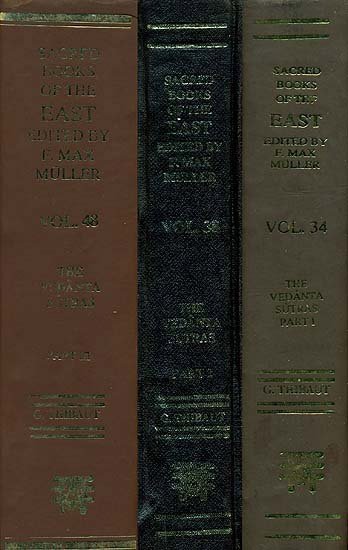Brahma Sutras (Ramanuja)
by George Thibaut | 1904 | 275,953 words | ISBN-10: 8120801350 | ISBN-13: 9788120801356
The English translation of the Brahma Sutras (also, Vedanta Sutras) with commentary by Ramanuja (known as the Sri Bhasya). The Brahmasutra expounds the essential philosophy of the Upanishads which, primarily revolving around the knowledge of Brahman and Atman, represents the foundation of Vedanta. Ramanjua’s interpretation of these sutras from a V...
Sutra 3.3.18
18. The new (thing is enjoined); on account of the statement of what has to be done.
The Sūtra discusses an additional question connected with the meditation on breath. Both texts—the Chāndogya as well as the Vājasaneyaka-declare that water constitutes a dress for praṇa, and refer to the rinsing of the mouth with water. The doubt here arises whether what the texts mean to enjoin is the rinsing of the mouth, or a meditation on prāṇa as having water for its dress.—The Pūrvapakshin maintains the former view; for, he says, the Vājasaneyaka uses the injunctive form 'he is to rinse,' while there is no injunctive form referring to the meditation; and what the text says in praise of the breath thus not being allowed to remain naked may be taken as a mere glorification of the act of rinsing. And as ordinary rinsing of the mouth, subsequent to eating, is already established by Smṛti and custom, we must conclude that the text means to enjoin rinsing of the mouth of a different kind, viz. as auxiliary to the meditation on prāṇa.—To this the Sūtra replies that what the text enjoins is the new' thing, i.e. the previously non-established meditation on water as forming the dress of prāṇa. 'On account of the statement of what has to be done,' i.e. on account of the statement of what is not established—for only on the latter condition Scripture has a meaning. The beginning as well as the end of the Vājasaneyaka-text clearly refers to a meditation on the water used for rinsing as forming a dress for prāṇa; and as rinsing is already established by Smṛti and custom, we naturally infer that what the text enjoins is a meditation on breath as having the water used in rinsing for its dress. This also explains why the Chāndogya-text does not mention the rinsing at all, but merely the clothing of breath with water.—Here terminates the adhikaraṇa of 'the statement of what has to be done."
